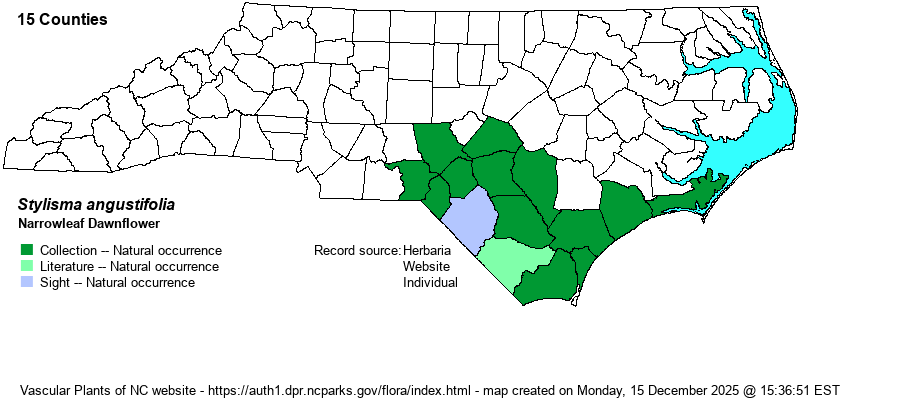| Author | (Nash) House | |
| Distribution | Limited to the southern Coastal Plain, mainly the Sandhills region and areas to the southeast. Ranges north to Carteret, Harnett, and Moore counties. The current name reflects an elevation to species status of the former Bonamia (= Stylisma) patens var. angustifolia (in RAB 1968).
This is a Southern species ranging from southern NC south to central FL and to AL. | |
| Abundance | Infrequent to fairly common in the Sandhills region; uncommon to infrequent farther eastward to Pender and Brunswick counties, and rare northeast to Carteret County. As the NCNHP does not have the species on its Watch List, its State Rank of S2 is not appropriate, and the website editors have moved the State Rank to a more reasonable S3. | |
| Habitat | This is a species of sandy places, normally found in Longleaf Pine (Pinus palustris) sandhills. It also can grow along roadsides and other sandy places, away from high quality sites. | |
| Phenology | Blooms from May into August, ans fruits shortly after flowering. | |
| Identification | This is a slender herbaceous vine, trailing on the ground to about 3-4 feet long. It has alternate and very slender leaves, linear to very narrowly lanceolate, about 2 inch long but barely 1/5-inch wide. From the axils grow 1-3 small flowers, on stalks around 1-inch long, each white flower being funnel-shaped but barely 4/5-inch long and across. There are several similar species, also prostrate like this. S. patens has shorter and wider leaves, each one about 1-inch long and about 1/4-inch wide, mostly about 4-6 times as long as wide, as opposed to about 7-15 times as long as wide in S. angustifolia. Also, this latter species has quite hairy sepals, whereas those of S. angustifolia are glabrous. The quite rare S. pickeringii has even narrower leaves, about 2 inches long but barely 1/10-inch wide, essentially needle-like, and usually stiffy erect; its flowers are also quite erect and have villous sepals. S. humistrata also grows in sandy places like these others but its leaves are about 1/2-inch wide and the flowers grow 3-7 (on average) in a cluster instead of mainly just singly. Biologists who work in the sandy parts of the southern Coastal Plain are probably familiar with all four of these and can identify each without much problem, even by the leaves. However, for many other people, you may have to collect or measure a leaf or look at the sepals or other characters to be sure. | |
| Taxonomic Comments | All of these Stylisma species were at one time in the genus Bonamia. Some references, such as NatureServe, do not consider this a valid species, and treat it as a variety or subspecies of S. patens.
| |
| Other Common Name(s) | None | |
| State Rank | S2 [S3] | |
| Global Rank | G5T4 [G4] | |
| State Status | | |
| US Status | | |
| USACE-agcp | | |
| USACE-emp | | |

